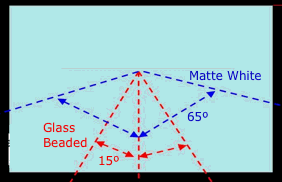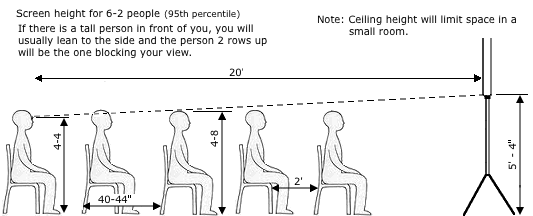|
With the advent of video projectors replacing overhead projectors and 35 mm movie projectors the choice of screens has grown exponentially.

There are screens with more reflective finishes (called gain) designed to enhance brightness, but they have a narrower viewing angle than a matte screen. The gain number represents a ratio of the light that is reflected from the screen as compared to the light reflected from a standard white (magnesium oxide) board. Typical home theater screens have gain from 1 - 1.3.
Screens with higher gain have a lower angle of view.
A glass beaded screen with a gain of 2.5 has a 30° angle of view and is difficult to clean.
The Vutec Silverstar advertises a Gain of 6.0 and advertises a 180° viewing area.
Some screens are brighter than others. Published gain values may not be comparable from vendor to vendor. The image may be brighter, but since the viewing angle usually decreases inversely to the gain, a bright screen may be more of a sacrifice than a pleasure. High gain screens may also reduced image sharpness.
See:
ProjectorCentral.com: Relative brightness of home theater projection screens
How do projector screens differ?
The High-Gain/Exotic Screen Review - AVS Forum
Screens may be of tensioned or non tensioned variety. Tensioned models attempt to keep the fabric flat and immobile.
Some tilt forward to avoid a keystone image (top wider than the bottom).
The standard was white screens, but Stewart Filmscreen introduced a grey screen in 2001.
The gray screen absorbs ambient light that strikes it better than a white screen does. In so doing the black level on the screen is maintained. Sometimes called dark screens.
A grey screen will have a gain around 0.8

Size:
The old standard tripod stand screens varied, 70"x70" was common for 8 mm film movies people of my generation saw in school, smaller sizes for home use have been around for a while 50"x50", 43"x57", 51"x67" (84" diagonal), 60"x80" (100" diagonal).
Viewing Distance:
Da-Lite.com
recommends the following formula for determining screen size:
Commercial and educational applications.
- Screen height should be approximately equal to 1/6 the distance from the screen to the last row of seats, allowing text to be read and detail to be seen in the projected image. Ideally, the first row of seats should be approximately two screen heights away.
So for the 80" diagonal Epson Duet Ultra Portable (below) with a 39 in height the last row could be 20 feet away; the first row should by 6.5 ft..
- The bottom of the screen should be a minimum of 4 feet above the audience floor, allowing those seated toward the rear of the audience to see the screen. This may require additional screen "drop" for ceiling hung screens.
 Viewing angle for home theater:
Viewing angle for home theater:
Widely sited research by the Japanese broadcasting company NHK found that 30 degrees is the minimum viewing angle needed to create an immersive "sensation of reality" in most viewers. i.e. If you are farther away it becomes less real.
Another consideration is visual acuity. Details smaller than 1/60th of a degree cannot be discerned. For 1080p the minimum viewing angle is 32°. If you are farther away you will miss some detail. For 720p it is 21°, so for the 100 in diagonal screen you should be within 19.5 ft.
See Visual Acuity of the Human Eye at Iowa State U. - Nondestructive Testing (NDT) center.
A horizontal viewing angle (from one side of the screen to the other) of 30° - 40°, is usually recommended, with 36° considered optimal. It is personal, do you like to sit in the front or back of a movie theater?
You can sit closer to High Definition (HD) picture without seeing the pixels (grain) than a Standard Definition (SD) picture.
See:
GADGETBENCH - Screen Size
Theater Build: Mike's Money Pit - AVS Forum
Da-Lite.com
recommends screen height be approximately equal to 1/4 the distance from the screen to the last row of seats.
So for the Epson Duet Ultra Portable (below) with a 39 in height the last row could be 13 feet away.
Movie Theaters:
In movie theaters the screens are even wider; The most common aspect ratios used today in the presentation of films in movie theaters are 1.85:1 and 2.39:1. CinemaScope can be up to 2.6:1.
This compares with 1.78:1 for 16:9 used in High-Def (HD) TV,
4:3 (1.33:1) for standard definition TV (SD), and 4.5:3.3 (1.36:1) 8 mm film and 5.79x4.01 (1.44:1) for super 8 film.
Screen height for multi-row audience:

See Human Dimensions
Of course if you are 5-2 and the person two rows up is 6-2 the bottom of the screen would have to be 8 ft above the floor.
Note: Home Theater systems usually solve the problem by raising each row as you go back.
At ProjectorCentral.com they recommend:
* The Epson Duet Ultra Portable advertises a 42" high screen, but that is the case height the actual screen in 39". 39 x 52 (65" diagonal) for 4:3 or pulls out to 70" (80" diagonal) for 16:9 (HDTV). It comes with a stand and a wall mounting bracket.
You can also use a wall treated with special paint (such as Screen Goo).
Home Theater systems and Media Rooms can get expensive.

Prices below assume a projector capable of High definition Video, at least a 720p display which will accept 1080p input and a 5.1 (5 satellite speakers plus a woofer) or 7.1 surround sound system.
You can add a Home Theater system to your family room or build a media room like the one to the right.
You can spend up to $100,000 for a top of the line system and custom built room according to Electronic House.
| Component | Good1 | Very
Good1 | Excellent | Audio/
Videophile | Home
Theater
Mag2 |
| Projector 3 | $650 | $900 | $1,500 | $4,000 | $8,000 |
| Screen 4 | $115 | $200 | $1,000 | $2,200 | $2,200 |
| Blu- ray player | 705 | $100 | $270 | $500 | $500 |
| Surround Sound | | | | | |
| AV Receiver | $300 | $400 | $630 | $800 | $9,500 |
| Speakers | $200 | $800 | $1,800 | $3,000 | $21,500 |
| Equipment total | $1,265 | $2,400 | $5,200 | $10,500 | $41,700 |
| Room construction * | | | $5,000 | $12,000 | |
| Acoustial Design | | | | $2,000 | |
| Video Calibration | | | | $500 | |
| Total | | | $10,200 | $25,000 | |
1. Note: Good/Very Good is relative. The components listed under good here usually get a "very good" rating at Consumer Reports and CNET, which rate systems for the mass market.
However, in the system picks at the 2012 Home Theater Magazine, Buyers guide, aimed at high end users, a Good system comes in at $3,300; Better - $7,300; Best - $10,100, for equipment only.
2. Home Theater Mag 2012 buyers guide top of the line system. A $10,000 system was also listed as "Best".
3. Home Theater Magazine recommends flat pannel displays for all but their top system. Their top pick the 65" Pasonic P65VT30 plasma is about $2,800.
Projection systems can produce images of 100" or more. Larger the screens require more powerful the projectors. Projectors usually have a slower frame rate and are not as bright. 15-20 ftL (foot Lamberts) for a projector vs 37 ftL for a flat panel display.
4. A larger screen requires a larger room. Recommended viewing distance for a 65" (1080p) screen is 7-9 ft.; for a 100" screen is 10-13.5 ft.
5. You can get a combination AV receiver, blu-ray player and speakers like the Panasonic SC-BT200 for $600
* You can add a system to an existing family room for minimal cost such as mounting a screen and wiring. Construction prices for a custom media room can vary all over the place depending on whether you are converting a basement or adding on a whole new room. For systems over $15,000 an acoustical design consultant is recommended.
You can add a custom computer to
control the system and put your
video library on a large disk array also.
See:
Electronics Design Group
How Much Will My Home Theater Cost? at ElectronicHouse.com
Home Cinema at Wikipedia
Sound and Vision Magazine | Home Theater and Stereo Reviews, Best HDTVs, Music, Blu-ray discs
Home Theater Network
Custom Home Theater Acoustics at Kinetics Noise Control
Home Theater Magazine
Goodwin's High End Home Theater
ABCedia of Design
|
Terms:
CE - Consumer Electronics
CEDIA - Custom Electronic Design and Installation Association. A global trade association of companies who specialize in home automation, networking, communication, security, lighting control, HVAC and entertainment systems.
HAA - Home Acoustic Alliance
IRE
SMPTE - Society of Motion Picture and Television Engineers
THX - THX is mainly a quality assurance system. THX is a trade name of a high-fidelity audio/visual reproduction standard for movie theaters, screening rooms, home theaters, computer speakers, gaming consoles, and car audio systems. They certify movie theaters, home theater components, video displays and other A/V systems for quality.
THX.com
Links:
Projectors
Blu-Ray player
Choosing Projector Screens at ProjectorReviews.com
How to buy a screen at ProjectorCentral
Projection Calculator Classic - Throw Distance and Screen Size
Selecting the Right Screen at Da-Lite.com
Projector Screen Reviews at ProjectorCentral
Theater Seating Manufacturer Home Theater Chairs, Auditorium, Church Pews
Home Theaters at DIY Network
Home Toys Article - June 2005 - Understanding Projector Screens
last updated 13 Dec 2011
|
 Products
Products
 Projector Screens
Projector Screens
 Products
Products
 Projector Screens
Projector Screens
 Viewing angle for home theater:
Viewing angle for home theater: